I realized that the molecules of my body, and the molecules of the spacecraft, the molecules in the body of my partners, were prototyped, manufactured in some ancient generation of stars. And that was an overwhelming sense of oneness, of connectedness; it wasn’t ‘Them and Us’, it was ‘That’s me!’, that’s all of it, it’s… it’s one thing. And it was accompanied by an ecstacy, a sense of ‘Oh my God, wow, yes’, an insight, an epiphany.’
Edgar Mitchell on returning from the Moon.
Like humans throughout history, I often gazed up at the night sky and wondered what was out there. Our first nations people created stories about the celestial objects and saw them as the playthings of the gods.

.As a pyrotechnically active child I thought about how to launch myself into space. I wondered if I could procure a sky rocket with sufficient thrust.

I became increasingly awed and amazed by the pioneering ace high expeditions being undertaken into space by astronauts and cosmonauts.
From Russia with Love
For over 60 years the USSR was responsible for a number of pioneering accomplishments in space flight.
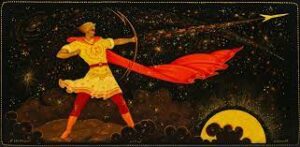
On 12 April 1961, the headlines were full of the incredible news: Yuri Gagarin had become the first human being in space.
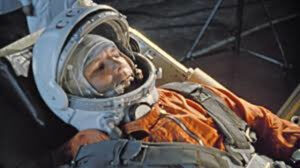
He orbited the earth in the spacecraft Vostok.

He became a beloved national hero of the Soviet Union and Eastern Bloc.
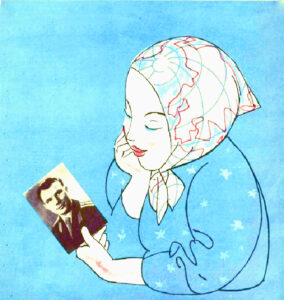
His ‘second orbit’, his world wide tour followed, becoming the most successful diplomatic mission in history. Thousands of ordinary people turned out to see this envoy of peace during his stay in England. With his charming smile he received a welcome equivalent to that of a movie icon. The roaring, waving welcome everywhere he went was warm and spontaneous beyond comparison.

This ‘Columbus of the Space Age’ made a lasting impression on the British people.
I was happy to hear that politically acceptable compromises eventually allowed the visit to include engagements with Prime Minister Macmillan and Douglas Home in Whitehall and with the Queen at Buckingham Palace.

Macmillan, whose government was initially negatively disposed towards the unexpected hero from the USSR, resisted calls from diplomats in West Germany to shun the visit, called Yuri ‘a delightful and wonderful fellow’.

I would congratulate Macmillan on what I saw as a smart move.
Yuri’s visit included a homage to a site of note to Soviet people, Highgate Cemetery – the resting place of Karl Marx.

Gagarin flew up to Manchester as a guest of the Amalgamated Union of Foundry Workers, who invited this former steel worker to an engineering plant .

He recalled later, ‘The firm handshakes of my fellow workers meant more to me than many awards’.
He was guest of honour at a civic reception at Manchester’s town hall where the hammer and sickle flew over the city and the Soviet anthem was played.
Ever a man of the people, when Yuri saw that the crowds lining the Mancunian streets to see him were getting wet, he insisted on lowering the roof of the convertible Rolls-Royce in which he travelled.
“Surely the least I can do is get wet too,” he said.
The visit eased international tensions if only temporarily while it sparked my interest in space exploration which continues strong to this very day.
Like Yuri’s thirst for space’, the ‘final frontier’ beckoned to the explorer in me and was a launching pad for my interest in cosmology.
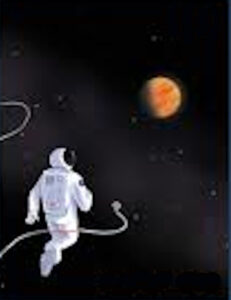
As for the space race, I wondered which side had the best German scientists. In the sixties the race was on the front page of the papers and I relished reading about it.
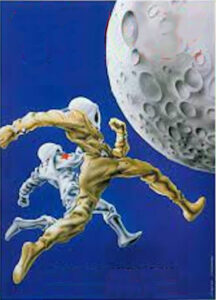
My childhood stories were coming true and gave rise to much reflection.

Gordon Cooper and Charles ‘Pete’ Conrad Junior greatly appreciated the hours I passed in watchful attention during their technically troubled, suspenseful yet productive Gemini 5 flight. They are seen below in a flight photo montage.

I told these two of a select few their journey was crucial and carried us into tomorrow.

Both men played a central role in the human spaceflight program of the United States.
One or the other rode the spacecraft used in all three manned programs which can be compared below : Apollo (top), Gemini (middle) and Mercury (bottom). In the lower left is a comparison of these programs’ launch vehicles: (left to right) The Saturn V, Titan II and Atlas.

Gordon Cooper was the first person to make two orbital space flights. On May 15-16, 1963, he circled the earth 22 times in the Mercury program spacecraft, Faith 7.
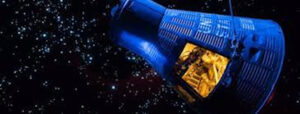
The program’s goal was to put a man into Earth orbit and return him safely, ideally before the Soviet Union.
Ham, the astrochimp had played a preparatory part in the program.

To train for his flight ‘Gordo’ had to perform many medical tests in the leadup to his flight. This involved special equipment such as the weight and balance scale.

He had to get used to lying on his back while preparing for blastoff.
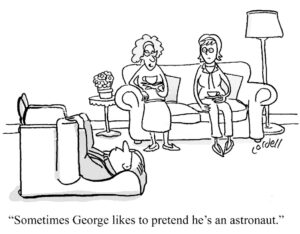
To sustain him on his mission ‘Gordo’ had to get used to sucking food from tubes.

During this flight, he released a 10 pound flashing beacon to test how far away he could see it. He estimated that he could see the light as far away as 17 miles. This experiment provided information for astronauts whose spacecraft carried out rendezvous in space.
“This natural born stick and rudder man,” became the first American to spend an entire day in space, the first to sleep in space, and the last American launched on an entirely solo orbital mission.
Project Gemini was a program to support the planned Apollo crewed lunar landing program. This added extravehicular activity to its objectives.

It added rendezvous and docking to them.

These sailors of the sky, Cooper and Conrad, slipped the surly bonds of Earth and orbited it 120 times over eight days in August 1965.

They set a new space endurance record by traveling 3,312,993 miles (5,331,745 km) in 190 hours and 56 minutes—just short of eight days—giving high hopes, showing that astronauts could survive in space for the length of time necessary to go from the Earth to the Moon and back.
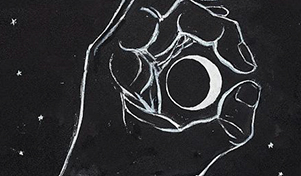
Gemini 5 was the first spacecraft with fuel cells, devices that produced electricity from the chemical reaction between a fuel and oxygen.
The men ejected the Rendezvous Evaluation Pod (REP) from the spacecraft for simulated rendezvous manoeuvre experiments. The REP is seen in this artist’s concept.
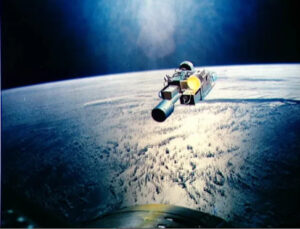
For this Gemini flight, the rookie Neil Armstrong was backup Command Pilot.

Pete Conrad would go on to command the Apollo 12 mission that made the second manned landing on the moon. Scientists like african american Katherine Johnson had worked out the necessary calculations to enable this.

Wearing replica space suits, the crew underwent rigorous, advanced training. This prepared them for takeoff and walking on the lunar surface.

Pete had a confident manner, a trait that calmed his crewmates during difficult in-flight conditions. He and Alan Bean landed in their lunar module, Intrepid, on the Ocean of Storms On November 19, 1969 —after a flight of 250,000 miles and a launch that included a harrowing lightning strike.

They stayed for 31 hours while their friend Richard Gordon remained in lunar orbit, photographing landing sites for future missions.

The crew of Apollo 12. L-R: Charles “Pete” Conrad, Richard Gordon, and Alan Bean.
It feels just like it was yesterday following these missions: sitting on the carpet before the terrestrial television set, legs crossed, glued to the flickering black-and-white images, following every detail: Conrad and Cooper making their way towards their spacecraft,

workers helping Cooper[left] and Conrad strap in to Gemini 5,

their spacecraft hoisted atop the launch vehicle,

the launch with the crackling of the ignition flames and the incredibly violent shaking, vibrating and rumbling.

The spectacular view of Cape Kennedy, Florida the day after the launch.

Finally after splashdown, the welcome sight of the navy divers jumping out of a rescue helicopter to transfer them from their spacecraft into a life raft.

During their goodwill visit to Greece, stop in Athens, these bravest of the brave met with the crew of Voskhod 2, Soviet cosmonauts Pavel I. Belyayev and Aleksei A. Leonov, who completed the first walk in space six months earlier.

Cooper said beforehand that from Gemini 5 “you don’t see any of the combat, you don’t see any of the fighting and bickering, the world looks like a very peaceful place.”
In the case of Apollo 12 we saw the crew looking back on earth through the window of the Saturn V launch vehicle as it’s horizon slowly curved around in upon itself . Then to see the full circle of this fragile jewel hung up in the blackness of space, it’s snow and clouds pure white, it’s oceans crystal blue, it’s land brown ; the injection into the lunar trajectory, the descent to the moon’s dusty surface– the scientific explorers in bulky white spacesuits lowering their feet to a new terra firma. Maybe not so firma for Pete. His first words as he stepped on the moon were, “Oooh, is that soft and queasy. Then he said ‘Man, that may have been a small one for Neil, but that’s a long one for me,” his was a nod to a height difference between the 2 astronauts – Neil Armstrong was 5’11” (1.8m) tall while Pete was 5’6” (1.7m).

“I knew that I had seen something few humans in all history would ever directly experience – the earliest footprints on a world beyond our own.
Alan Bean described the sensation upon landing: ‘When you land on the moon and you stop and get out, nobody’s out there. This little LEM and then the two of you on this whole big place, you’re it, and that’s a weird feeling.’ What struck them was the vivid contrast between this celestial desert and the black sky.
Alan can be seen working at the Modular Equipment Stowage Assembly on the Apollo 12 Lunar Module during the mission’s first extravehicular activity.
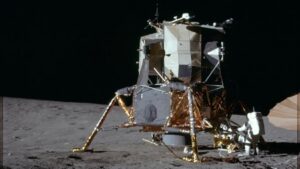
Then followed their slow-motion dance- hopping up and down on the lunar surface, skipping, and even driving across the terrain of our nearest neighbour in the sky. Alas I didn’t get to see Pete dance.

Since the television camera gave out, there’s virtually no footage of Conrad and Bean on the moon. Alan Bean thought ‘if only I had my easel and paints here.’

It was left to him back on Earth to later depict various lunar scenes.
Otherwise it was a dream mission. ‘Pete Conrad Has a Fun Trip to the Moon read the headline.” No astronaut enjoyed his flight to the moon insofar as Pete did. Known for his colourful and comedic side, Pete’s first words as he descended the Lunar Module ladder, moments before becoming the third human to walk on the Moon were, “Whoopee! Man, that may have been a small one for Neil, but that’s a long one for me!” It was a long step for Pete but a short one for posterity.
Spaceflight being a dangerous and unforgiving enterprise is sufficient reason for astronauts to seek relief in humour and an appealing personality. Pete was almost like a child on Christmas Day, and his companions had a pretty good time too.

And productive too. Conrad and Bean set up scientific instruments. Commander Conrad can be seen setting up the Apollo Lunar Surface Experiments.

They collected soil samples and rock . The Moon’s surface being dominated by igneous rocks, they collected samples of basalt, some of which had been extruded as lava earlier before the main body.
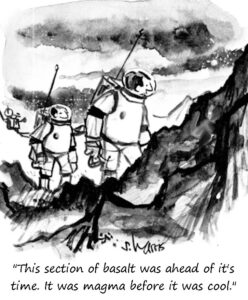
For the Moon to be able to sustain human life, water must be available.

The Apollo missions found no trace of water. It would take later missions to help confirm the discovery of water locked in minerals on the Moon.
The Apollo 12 crew also removed parts from Surveyor III, an unmanned spacecraft that had landed on the moon in April 1967. Below you can see Pete next to it with the lunar module on the crater rim just 182m away.

Below can be seen the paths of Conrad and Bean’s two moonwalks, which totalled almost eight hours.

On their safe return there was a huge sigh of relief on Earth.

The capsule’s parachutes proved to have been undamaged by the lightning strikes and deployed without a hitch.

They combined courage, discipline, intelligence, enthusiasm, and an unstoppable pioneering spirit with a legendary sense of sheer joy, excitement and humour. He and his crew had an extraordinary ability to confidently undertake the most difficult journeys—and to have fun along the way.
This jovial attitude continued from Pete after his return.
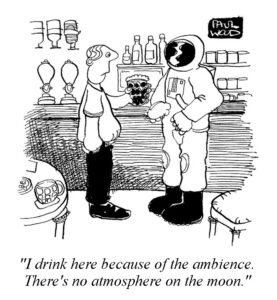
On his Gemini 11 flight, when he was flying higher than anyone had ever flown, Pete looked back at the Earth and said, “Eureka, Houston, the Earth is really round!” He got a good laugh when he got back to Houston and was flooded with mail from members of the Flat Earth Society telling him he didn’t know what he was talking about.
After Apollo, when space stations marked the next phase of space exploration, Pete commanded Skylab 2, the first crewed Skylab mission. On the 1973 mission, he and his two crewmates repaired significant launch damage to the Skylab space station. One of the solar array wing panels was missing while the other was only partly deployed, held down by debris from the torn micro-meteoroid shield.

The trio spent 28 days in the Skylab Workshop, conducting many medical and other experiments. Below Pete can be seen almost literally standing on his head in the weightlessness of space with only a restraint around his left leg holding him in position.

Pete smiled happily for the camera after a hot shower in the crew quarters.

Alan Bean spoke of how their lunar exploration had allowed him to put life into perspective and appreciate it more :”I feel blessed every single day. Not a day goes by that I don’t think this is great. This was wonderful. I have not complained about the weather one single time. I’m glad there is weather. I’ve not complained about traffic. I’m glad there are people around. One of the things that I did when I got home – I went down to shopping centres, and I’d just go around there, get an ice cream cone or something, just watch the people go by, and think: “Boy, we’re lucky to be here. Why do people complain about the Earth? We are living in the garden of Eden.
I imagined both Americans and Soviets preparing this garden and working together co-operatively.

I imagined them helping themselves as well as all nations by removing exploratory endeavours in space from the bitter and wasteful competition of the Cold War.

The Artemis Program is intended to reestablish a human presence on the Moon. Its stated long-term goal is to establish a permanent base on the Moon to facilitate human missions to Mars.

The continued upward trajectory of space flight is in the hands of these explorers.

The Meaning of Life.
I think I am, therefore, I am… I think.
George Carlin
Existentialist thinkers argue that humanity has to resign itself to recognizing that since a fully satisfying rational explanation of the universe is beyond our reach, the world must ultimately be seen as absurd. While I believe that the universe is a chance event, I believe that through science we are approaching as night follows day a more satisfying rational explanation for it – although it is an elusive quest, I believe existence is as meaningful as you make it.
The existentialist’s ability to portray the inner world should complement this knowledge rather than compete with it. Subjectively I feel very much like Beckett’s woman up to her neck in it, but objectively I know that death is a necessary event.